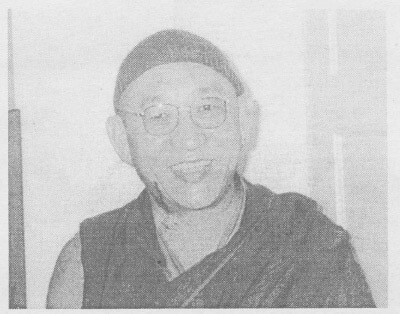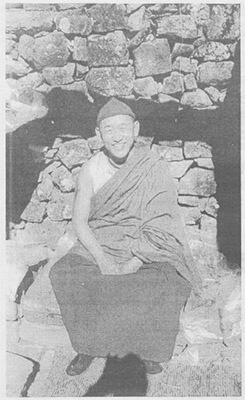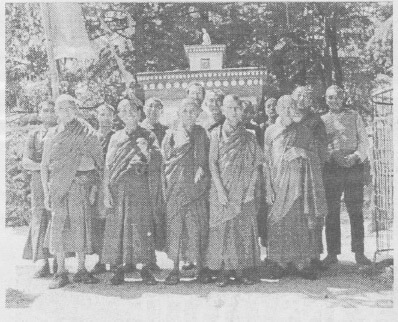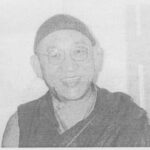| The following article is from the Winter, 2004 issue of the Snow Lion Newsletter and is for historical reference only. You can see this in context of the original newsletter here. |
BY VEN. TENZIN CHOERAB
Venerable Jampel Tenzin, known to his Western students as Gen Lamrimpa, passed as glorious as he lived. A lifetime meditator, he unified his words and his actions. Humility to the nth degree, kindness and love consistently given to all those whom he came in contact, and a wisdom that clearly recognized reality were his trademarks. His smile lit up the sky and made one feel inner joy and contentment.
Gen Lamrimpa lived most of his adult life in Dharamsala, Northern India. Initially, in the early 1970's, he lived for several years moving from cave to cave at the top of the mountains above Dharamsala. Often without food, meditating in a foggy and often wet place under a large rock overhang, he never feared. Food always seemed to appear when he really needed it. Many times self- rationed flour was about to finish, or was finished for one or two days, and almost like magic, or a gift from the buddhas, more flour, and maybe tea, or if very fortunate a little butter and tsampa (roasted barley flour) would arrive. These years of physical hardship, he told me later, were the best years for meditation; even though he claimed not to know much at that time.
Later he moved to a mud and stone one-room retreat hut where several other retreatants lived and practiced above the Tibetan Children's Village (TCV) near Trijang Rinpoche's Stupa. There he stayed nearly 18 years. Until 1990 he had no electricity, nor water. Water had to be fetched from afar, by carrying 40-50 lbs. of water up and down steep slopes often through snow or mud. Using candle and daggum (thick woolen Tibetan cape used for warmth during winter meditation), he meditated from 5 a.m. until 1 a.m. There were no week-ends or holidays off. There were breaks for preparing and eating food, gathering wood and fetching water, and occasionally teaching students who came by after lunch.



Clockwise: Gen Lamrimpa sitting on the porch of his mud/stone retreat hut in the mountains above Dharamsala, where he lived for about 21 years; portrait of Gen Lamrimpa Inter in his life; Gen Lamrimpa standing with the community of life-long meditators living in the mountains above Dharamsala near Trijang Rinpoche's Stupa.
After one of my regular weekly afternoon-evening visits to receive teachings, with a full stomach of Genia's simple, yet delicious food, Genia told me to be careful of snakes. I told him there were no snakes here in the Himalayan foothills at 6000 feet elevation. He was silent, and handed me a torch (flashlight). Off I went with torch in hand. Soon crossing the path in front of me was a snake, (not a rope), the only one I saw in my many years in Dharamsala.
Last October 30th, about 4:30 a.m. I felt he was calling me. As I went into his room, he opened his eyes, and asked me to help sit him up and give him some water. Along with the water I gave him chin.lap (blessed substances). After three deep breaths, he stopped his gross breathing. Sitting behind him on his meditation seat, I held his back straight for several hours, then secured him using a mediation belt lying nearby. For five days his body remained fresh, and his mind remained in meditation in the state of clear light unified with emptiness―a remarkable, extraordinary achievement. Those of us who knew him were not surprised. He passed as he lived: clear, profound, and spacious.

Humility to the nth degree, kindness and love consistently given to all those whom he came in contact, and a wisdom that clearly recognized reality were his trademarks.
Genla was cremated on November 4th. Three days after the ash was sifted for bones. Some had turquoise, others red colors within portions of the bones. Barry Kerzin (a medical doctor) wrote: Something I have never seen before. Quite beautiful.
A little stupa was or is being erected at the burial site outside of Gangtok.
Gen Lamrimpa is the author of Calming the Mind: Tibetan Buddhist Teachings on the Cultivation of Meditative Quiescence, translated by B. Alan Wallace, edited by Hart Sprager ($12.95). Because Gen Lamrimpa was such a meditation master, he is eminently able to lead meditators step-by-step through the stages of meditation and past the many obstacles that arise along the way as well as clearly discuss the qualities of mind that represent each of nine levels of attainment and the six mental powers.
He also wrote Realizing Emptiness: Madhyamaka Insight Meditation ($14.95), also translated by B. Alan Wallace. Here he draws on his theoretical training as well as his years of solitary meditative experience to show students, in a practical and down-to-earth way, how they can gain realization of ultimate reality.

